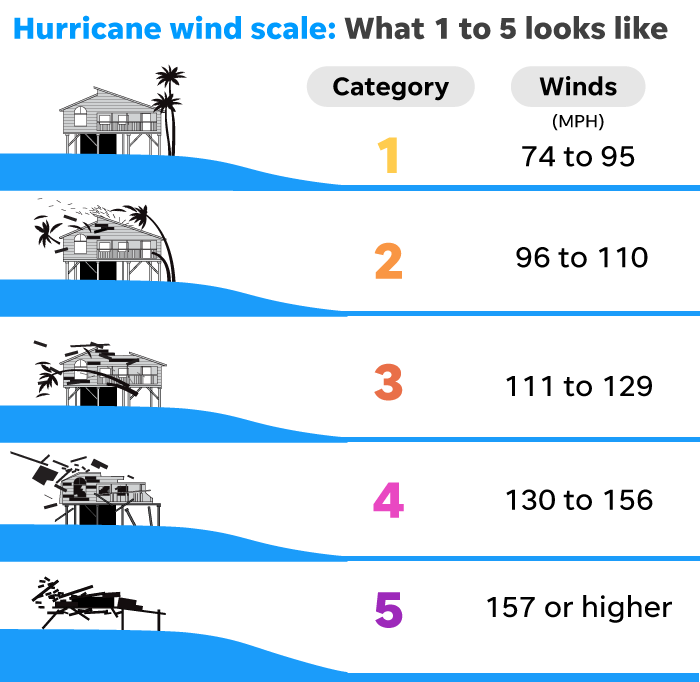'Uninhabitable for weeks or months': Why Helene's hurricane category matters
Editor's note: Read USA TODAY's coverage of Helene's landfall and impacts for Friday, Sept. 27.
As monster storms like Helene approach the U.S., meteorologists use five categories to help signal the life-or-death consequences for residents in the path.
This scale – officially known as the Saffir-Simpson Hurricane Wind Scale – is a rating based on maximum sustained wind speed, which ranges from 74 to 157 mph, or higher.
But it's important to note that the scale does not take into account potentially deadly hurricane hazards such as storm surge, rainfall, flooding and tornadoes. These hazards require people to take protective action, including evacuating from areas vulnerable to storm surge.
A new category?: 'Category 5' was considered the worst hurricane. There's something scarier, study says.
Hurricane Helene, now barreling toward an expected landfall on the Florida Gulf Coast Thursday evening, is forecast to increase in wind speed as it approaches the coast. As it gains power, it will also increase in categories on the official hurricane wind scale, which goes from 1 to 5.

What is the Saffir-Simpson Hurricane Wind Scale?
The Saffir-Simpson scale matches wind speeds with examples of the type of damage and impacts those winds could cause in the USA. In general, damage rises by about a factor of four for every category increase.
Watch the video below for a visual breakdown of the Saffir-Simpson scale of hurricane intensity for each category.
The scale was developed by structural engineer Herbert Saffir in 1969 as part of a United Nations project. It was later adapted by meteorologist Robert Simpson in the early 1970s, and it has been an integral tool for alerting the public about the possible impacts of various intensity hurricanes ever since, the National Hurricane Center said.
How much damage could Helene do in Florida?
Helene's true toll will depend on where it makes landfall, and how its other effects like flooding, storm surge and tornadoes unfold. But its wind speed and category at landfall will especially affect power outages and structural damage.
A Thursday forecast from the National Hurricane Center shows the hurricane approaching landfall Thursday night as a Category 3 with winds near 115 mph. Meanwhile, AccuWeather forecasters were predicting Helene would reach Category 4 strength in the Gulf and maintain that intensity through landfall.
If it does hit at Cat 4 power, the storm by definition would be be expected to leave a trail of "catastrophic" damage. The National Hurricane Center says Category 4 storms threaten well-built framed homes with "severe" damage, potentially losing both roof and walls. Most trees are snapped or uprooted and power poles are downed.
"Power outages will last weeks to possibly months. Most of the area will be uninhabitable for weeks or months," the hurricane center says of Category 4 storms.
A Category 3 storm, while significantly weaker, is still a major hurricane. "Electricity and water will be unavailable for several days to weeks after the storm passes," the center says of Category 3 storms.
What is a major hurricane?
Though all hurricanes produce life-threatening winds, hurricanes rated Category 3 and higher are known as major hurricanes. Major hurricanes can cause devastating to catastrophic wind damage and loss of life. Hurricanes of all categories can produce deadly storm surge, rain-induced floods and tornadoes.
Dangers explained: Hurricanes can kill from 1,000 miles away — and other terrifying dangers

What are the 5 hurricane categories?
Category 1 hurricane: 74-95 mphVery dangerous winds will produce some damage: Well-constructed frame homes could have damage to roof, shingles, vinyl siding and gutters. Large branches of trees will snap, and shallowly rooted trees may be toppled. Extensive damage to power lines and poles probably will result in power outages that could last a few to several days.
Category 2 hurricane: 96-110 mphExtremely dangerous winds will cause extensive damage: Well-constructed frame homes could sustain major roof and siding damage. Many shallowly rooted trees will be snapped or uprooted and block numerous roads. Near-total power loss is likely, including outages that could last from several days to weeks.
Category 3 hurricane (major): 111-129 mphDevastating damage will occur: Well-built framed homes may incur major damage or removal of roof decking and gable ends. Many trees will be snapped or uprooted, blocking numerous roads. Electricity and water will be unavailable for several days to weeks after the storm passes.
Category 4 hurricane (major): 130-156 mphCatastrophic damage will occur: Well-built framed homes can sustain severe damage with loss of most of the roof structure and/or some exterior walls. Most trees will be snapped or uprooted and power poles downed. Fallen trees and power poles will isolate residential areas. Power outages will last weeks to possibly months. Most of the area will be uninhabitable for weeks or months.
Category 5 hurricane (major): 157 mph or higherCatastrophic damage will occur: A high percentage of framed homes will be destroyed; there will be total roof failure and wall collapse. Fallen trees and power poles will isolate residential areas. Power outages will last for weeks to possibly months. Most of the area will be uninhabitable for weeks or months.
How common are each category?
Category 1 hurricanes are the most common, with as many as seven forming each year, according to Fox Weather. For comparison, only three Category 3s typically form each year.
Least common are the extremely rare Category 5s, of which there have only been four landfalls in U.S. history, Weather.com said.
(This story has been updated with new information.)
This article originally appeared on USA TODAY: How strong will Helene get? Hurricane category forecast explained.